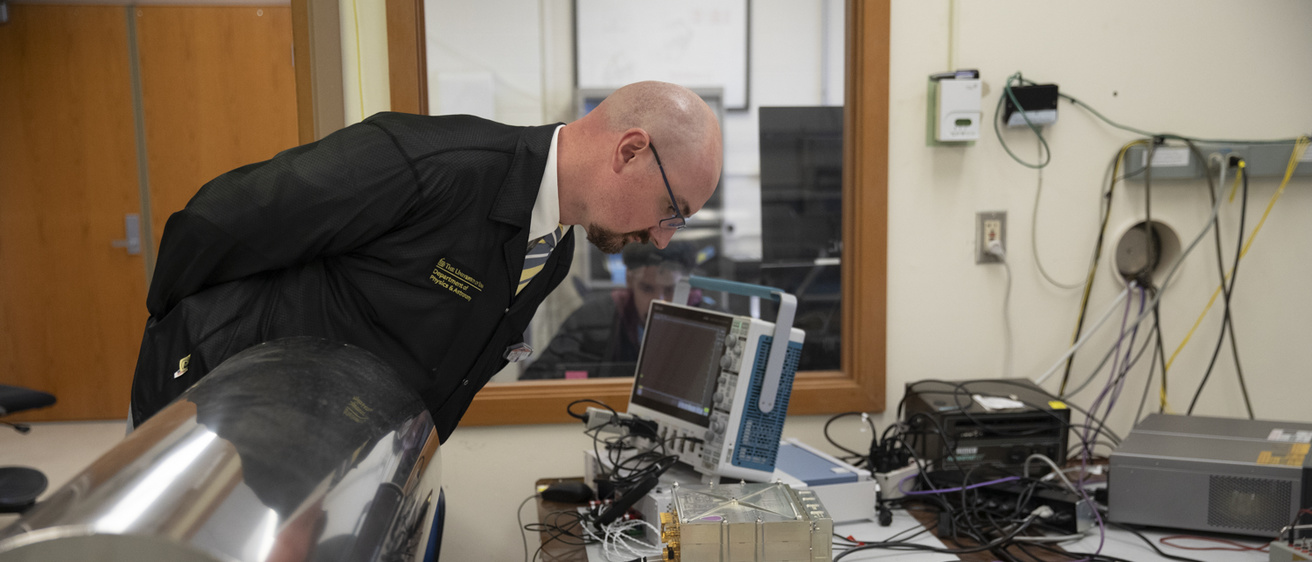David Miles, a University of Iowa associate professor of physics and astronomy, recently took over as the principal investigator on a satellite mission that will study the near-Earth orbit. Miles is leading the project after the death of UI professor Craig Kletzing in August.
“Craig was both a friend and a mentor to me and many others in the space physics community,” Miles said. “I will miss him, but I’m honored to have the opportunity to help his team make the TRACERS satellite mission a success.”
Miles has worked on other satellite missions in the past. Aside from the SpaceX TRACERS mission, he is also co-principal investigator of the e-POP instrument, a probe studying the magnetic field of the Earth’s ionosphere, on the CASSIOPE Polar Explorer.
“There are always new obstacles to be overcome, but I really enjoy it and I’m very proud of the team that we have working to make the project a success,” Miles said.
NASA announced the approval of $115 million in 2019 for a mission proposed by UI scientists last month to launch a satellite rideshare mission on a SpaceX rocket in 2025. The funding was the largest amount of external funding for the UI at the time.
As part of the Tandem Reconnection and Cusp Electrodynamics Reconnaissance Satellites, or TRACERS, task order, two satellites will collect data about the near-Earth space. The near-Earth space is the area’s interaction with solar wind and the plasma material that connects with the area.
The mission will include the launch of two spacecraft to the near-Earth environment. The leading spacecraft will measure a process called reconnection, which is when plasma gets from solar wind into the Earth.
A second spacecraft will follow to measure whether this reconnection phenomenon occurs in one spot consistently, turns on and off, or if it moves all over the place.
Miles said the long-term scientific goal of the mission is to understand near-Earth space and to eventually be able to forecast it based on the sun.
“So in the same way that you have a weather forecast that tells you whether it’s going to rain or be clear a couple of days from now, we would like a similar thing for near Earth space,” he said. “TRACERS isn’t going to do that, but what it is going to do is to help us understand the physics of how what the sun does affects the Earth.”
Many of the instruments for the mission are being built at the UI by other professors and research scientists.
UI physics and astronomy professor Jasper Halekas is in charge of an instrument on one of the satellites that will measure speed and direction of electrons in the space plasma.
Halekas said the instruments on the TRACERS are the “ears and noses” of the craft sensing changes in the atmosphere surrounding the craft. Instruments will measure ripples in magnetic fields, electrical fields, and plasma surrounding the earth.
UI research scientist and engineer George Hospodarsky is building a different instrument that will measure the wave magnetic fields through voltage in wires.
Before the mission can launch, TRACERS is scheduled for a launch readiness review with NASA in April of 2025. The spacecraft will be on a SpaceX rocket with other spacecraft being launched for different SpaceX missions.
Once the spacecraft are in orbit, the first data will show trends about a month into collection.
The UI will also provide a unique opportunity for graduate students to study the near space environment. Associate Professor Allison Jaynes will head a program that will allow students to launch suborbital rockets that measure one orbit’s worth of data. These launches will begin once the satellites are in orbit.
Miles said he is looking forward to the first data collected from the mission.
“It is quite thrilling to turn the instrument on for the first time and to see that what you built with your own hands here at the university is now orbiting the Earth and taking scientific data,” Miles said. “That first 30 seconds of data where you prove that the instrument works, there’s very few things like it.”
By Grace Olson, Daily Iowan
